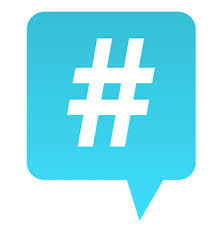Submitted by: Sydney Luther, Communications Assistant
This post is a part of a series on hashtag use. Click here for part two!
 A hashtag is a word or phrase preceded by a hash, number, or pound sign (#) and used to identify messages on a specific topic on social media websites. Hashtags are a way to tag the things you post, and a way to link to other people’s posts on the same topic. This tagging system can be used on virtually all social media, although is still most popular on Instagram and Twitter. A hashtag can include several words, but no spaces or symbols, only letters and numbers after the pound sign.
A hashtag is a word or phrase preceded by a hash, number, or pound sign (#) and used to identify messages on a specific topic on social media websites. Hashtags are a way to tag the things you post, and a way to link to other people’s posts on the same topic. This tagging system can be used on virtually all social media, although is still most popular on Instagram and Twitter. A hashtag can include several words, but no spaces or symbols, only letters and numbers after the pound sign.
The most common way to use a hashtag is to include an already popular one in your post, so people see it. If I have just created a piece of fibre art and I want to share it on Instagram and have people all over the world see it, I may include the hashtags #fibre, #art, #weaving or #crochet; anything related to the medium or technique I used. Using a hashtag means that my followers are not the only Instagram users who will see my post; anyone who’s looking at that hashtag will, too. Anyone who searches that term will see my artwork, may like the photo, and might even contact me to purchase it!
Social media blog Buffer Social writes that for best engagement, you should use two hashtags in a tweet (add any more and your engagement plummets), as many as you want on Instagram (although I would suggest not using more than a handful, so your post doesn’t look like spam), and probably skip them altogether on Facebook. Facebook’s hashtag search function doesn’t work very well, and since the majority of posts on Facebook are made privately (only shared to a person’s friends), the main point of a hashtag is lost (sharing your post to a wider public audience). The only reason I would use a hashtag on Facebook is to remind people that I want them to use it on other social media, like with a custom event hashtag (more about that in Part 2).

In this tweet we used the hashtag #citizensofcraft, referring to a movement by the Canadian Crafts Federation. Now our tweet will be linked to all other tweets about Citizens of Craft!
In my research on several sites that compare hashtag popularity, it appears that the shorter the hashtag, the higher the number of tweets using it. More people have tweeted about #fibre than #fibreart, more #blacksmith than #blacksmithing, and more #wood than #woodturning. It looks like #photo has higher engagement than #photography, #weaver is more common than #weaving, and #clay is more popular than #ceramic or something more descriptive like #ceramicsculpture. Instead of a long hashtag like #prairielandscape, I suggest using #prairies and #landscape. That way, anyone searching for each of those things will see your tweet, and people who search for both will see it, too.

It’s common practice to use a city’s airport code as a hashtag. Here, Aidan is referring to a meal he ate at The Beltliner Restaurant in Calgary (#yyc). For Saskatoon, use #yxe and for Regina, use #yqr.
However, a problem with these shorter hashtags is their meaning can become too broad. You have to toe the line between clear meaning, and using a popular hashtag. For example, one trend I’ve noticed is the increased use of #craft to refer to craft beer, rather than craft art. This wouldn’t always stop me from using that hashtag, but I may reconsider using a more descriptive one instead, like #finecraft. People looking at the hashtag #craft may be more interested in beer than your artwork, so using a specifically art related hashtag may be to your advantage.
There’s almost no wrong hashtag to use, except a hashtag that’s already being used exclusively for something else. Sometimes people want a unique hashtag to use for a specific purpose, like an event. If you’re looking for a unique hashtag, you need to do a little bit of research. For example, our friend Aidan Morgan wanted to set up a hashtag that people could use to easily ask him questions via Twitter. He considered #AskAidan, but once he searched for that hashtag, he realized it was already being used by an adult film star also named Aidan, so he had to come up with a Plan B.
As you can see, hashtag use is a trial and error process and not an exact science. I’m sorry I can’t give you a precise list of the best hashtags to use, because hashtag popularity is constantly changing. Why not give it a try, and see what works well for you? Social media is important for business as an artist, but it’s also supposed to be fun!
Click here to read part two of this post on hashtags, for more information on how to use them to promote events! Meanwhile, if you have more questions, check out this article by Hootsuite for another look at how to use hashtags.
